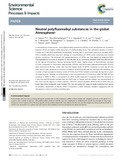Please use this identifier to cite or link to this item:
http://hdl.handle.net/10311/1279| Title: | Neutral polyfluoroalkyl substances in the global Atmosphere |
| Authors: | Gawor, A. Shunthirasingham, C. Hayward, S.J. Lei, Y.D. Gouin, T. Mmereki, B.T. Masamba, W. Ruepert, C. Castillo, L.E. Shoeib, M. Lee, S.C. Harner, T. Wania, F. |
| Issue Date: | 2014 |
| Publisher: | The Royal Society of Chemistry, http://pubs.rsc.org/en/journals/journalissues/em#!recentarticles&all |
| Citation: | Gawor, A. et al. (2014) Neutral polyfluoroalkyl substances in the global Atmosphere, Environmental Science: Processes & Impacts, Vol. 16, No. 3, pp. 404-413 |
| Abstract: | Concentrations of neutral per- and polyfluoroalkyl substances (nPFAS) in the atmosphere are of interest because nPFAS are highly mobile percursors for perfluoroalkyl acids. Two calibration studies in Ontario, Canada and Costa Rica established the feasibility of using XAD 2-resin based passive air samplers (XADPAS) to reliably determine long term average air concentrations of nPFAS under temperate and tropical climatic conditions. The temporal and spatial distribution of nPFAS was investigated by analyzing XADPAS deployed for one year at between 17 and 46 sites on six continents between 2006 and 2011 as part of the Global Atmospheric Passive Sampling (GAPS) study. Higher levels of fluorotelomer alcohols (FTOHs) compared to fluorinated sulfonamides (FOSAs), and fluorinated sulfonamidoethanols (FOSEs) were observed at all sites. Urban sites had the highest levels of nPFAS compared to rural and remote sites, which is also apparent in a positive correlation of nPFAS levels with the proximity of a sampling site to areas of high population density. Levels of FOSAs and FOSEs tended to decrease during the six years of measurements, whereas an initial decline in the concentrations of FTOHs from 2006 to 2008 did not continue in 2009 to 2011. A comparison of nPFAS levels measured in national XAD-PAS networks in Costa Rica and Botswana revealed that the GAPS sites in Tapanti and the Kalahari are representative of the more remote regions in those countries. XAD-PAS derived absolute nPFAS levels at GAPS sites are lower than those measured using another PAS, but are within the range of levels measured with active air samplers. Agreement of relative nPFAS composition is better between samplers, suggesting that the discrepancy is due to uncertain sampling rates. |
| URI: | http://hdl.handle.net/10311/1279 |
| ISSN: | 2050-7887 (Print) 2050-7895 (Online) |
| Appears in Collections: | Research articles (Dept of Chemistry) |
Files in This Item:
| File | Description | Size | Format | |
|---|---|---|---|---|
| Mmereki_ESPI_2014.pdf | 1.02 MB | Adobe PDF |  View/Open |
Items in DSpace are protected by copyright, with all rights reserved, unless otherwise indicated.
